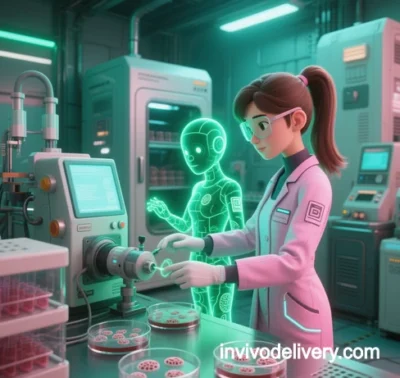
In Vivo Delivery: Applications in Gene Therapy, Tumor Targeting, and Personalized Medicine
In vivo delivery refers to the direct administration of bioactive substances (e.g., gene-editing tools, nucleic acid drugs, proteins) into target tissues or cells within a living organism. Its core value lies in overcoming physiological barriers to achieve precise therapeutic outcomes. Breakthroughs in viral engineering, nanotechnology, and synthetic biology have unlocked revolutionary potential in gene therapy, tumor targeting, and personalized medicine. Below is an in-depth analysis of technological advances, applications, and future directions.
I. Gene Therapy: From Rare Diseases to Systemic Repair
1. Technological Advances
- Viral Vector Optimization:
Adeno-associated viruses (AAVs) are engineered for organ-specific targeting (e.g., AAV9 crosses the blood-brain barrier to treat spinal muscular atrophy). Lentiviruses (LVs) with integrase mutations reduce insertional mutagenesis risks for hematopoietic stem cell gene repair. - Non-Viral Vector Innovations:
Lipid nanoparticles (LNPs) extend circulation half-life via PEGylation and enhance nucleic acid encapsulation efficiency (e.g., Moderna’s COVID-19 vaccine technology). CRISPR-Cas9-LNP complexes knock out the PCSK9 gene in hepatocytes to treat hypercholesterolemia.
2. Applications
- Monogenic Disorders:
Zolgensma® (AAV9-delivered SMN1 gene) significantly improves motor function in spinal muscular atrophy patients, with a 90% clinical response rate. - Systemic Disease Intervention:
LNP-based base editors (e.g., Verve Therapeutics’ VERVE-101) target hepatic ANGPTL3 to reduce cardiovascular disease risk.
3. Challenges & Innovations
- Immunogenicity Control:
Chimeric AAVs (e.g., Spark Therapeutics’ SPK-7001) evade pre-existing antibodies through capsid engineering. - Dose Precision:
Microfluidic chips produce uniform LNP sizes (<100 nm), enhancing liver targeting and reducing pulmonary toxicity.
II. Tumor Targeting: From Chemotherapy to Immune Cell Engineering
1. Technological Advances
- Smart Nanocarriers:
pH-sensitive polymers release doxorubicin in acidic tumor microenvironments, tripling drug concentration. Gold nanoparticles (AuNPs) combined with photothermal therapy enable chemo-thermal synergy. - In Vivo CAR-T Generation:
Nobel laureate teams developed Cas9-EDV platforms to generate CAR-T cells directly in mice by targeting T-cell receptors (e.g., CD3/CD28), achieving 80% tumor clearance without ex vivo expansion.
2. Applications
- Solid Tumor Penetration:
LNP-encapsulated siRNA (e.g., Patisiran) targets KRAS mutations in pancreatic cancer, enhancing efficacy when combined with PD-1 inhibitors. - Immune Microenvironment Modulation:
Exosomes deliver IL-12 mRNA to tumor-associated macrophages (TAMs), reversing immunosuppression and activating T-cell responses.
3. Challenges & Innovations
- EPR Effect Limitations:
Vascular normalization (e.g., anti-VEGF antibody pretreatment) improves nanoparticle tumor penetration. - Off-Target Toxicity Mitigation:
Dual-targeting ligands (e.g., folate + integrin αvβ3 antibodies) enhance tumor specificity, reducing toxicity to healthy tissues by 50%.
III. Personalized Medicine: From Gene Editing to Dynamic Regulation
1. Technological Advances
- Patient-Specific Vector Design:
AI predicts HLA haplotypes and viral capsid affinities to tailor AAVs for immune evasion. - Real-Time Monitoring & Feedback:
Liquid biopsy-CRISPR systems trigger LNP drug release via circulating tumor DNA (ctDNA), enabling closed-loop leukemia therapy.
2. Applications
- Genetic Disorder Customization:
AAV5 or LNPs deliver CRISPR repair templates based on F8 gene mutations, optimizing hemophilia A management. - Metabolic Disease Intervention:
Engineered E. coli deliver GLP-1 analog genes to gut epithelial cells for on-demand glucose control.
3. Challenges & Innovations
- Cost-Effective Production:
Modular platforms (e.g., Synthego’s CRISPRevolution) standardize component assembly for scalable personalized therapies. - Ethical & Regulatory Balance:
Organ-on-a-chip models (e.g., liver chips) simulate in vivo delivery metabolism, reducing animal testing by 30%.
IV. Future Trends & Technological Convergence
1. Synthetic Biology Integration
- Living Delivery Factories:
Engineered probiotics (e.g., EcN) synthesize anticancer drugs (e.g., 5-FU) in the gut, regulated by quorum-sensing systems. - Self-Evolving Vectors:
AAV capsid libraries (e.g., Dyno Therapeutics’ CapsidMap) evolve in vivo to yield highly specific variants.
2. Quantum-AI Synergy
- Molecular Dynamics Prediction:
Quantum computing simulates LNP-cell membrane interactions to optimize lipid composition for enhanced uptake. - Generative AI Assistance:
AlphaFold 3 predicts CRISPR RNP-capsid binding energy, guiding payload-vector compatibility.
3. Multi-Omics Integration
- Spatial Transcriptomics Navigation:
AI models trained on 10 nm-resolution spatial multi-omics data predict optimal delivery routes in liver lobules.
V. Ethical & Biosafety Challenges
- Germline Editing Risks:
Germline-targeting vectors (e.g., AAV-PHP.eB) must limit gonadal exposure (<0.1%). - Ecological Containment:
Self-destructing engineered bacteria (e.g., toxin-antitoxin E. coli) prevent horizontal gene transfer.
Conclusion
In vivo delivery is transforming medicine from “one-size-fits-all” treatments to programmable precision interventions. Future advancements will focus on:
- Precision: Dual-targeting systems (e.g., brain endothelial cells + neuron-specific promoters) minimize off-target effects.
- Intelligence: Environment-responsive carriers autonomously detect and repair diseased tissues.
- Democratization: Low-cost lyophilized LNPs and portable electroporation devices expand access to gene therapies in underserved regions.
As Nobel laureate Jennifer Doudna stated: “Breakthroughs in in vivo delivery will make gene editing as simple as taking an aspirin.” Realizing this vision requires interdisciplinary collaboration and a balance between innovation and ethical governance.
Data sourced from publicly available references. For collaborations or domain inquiries, contact: chuanchuan810@gmail.com.





